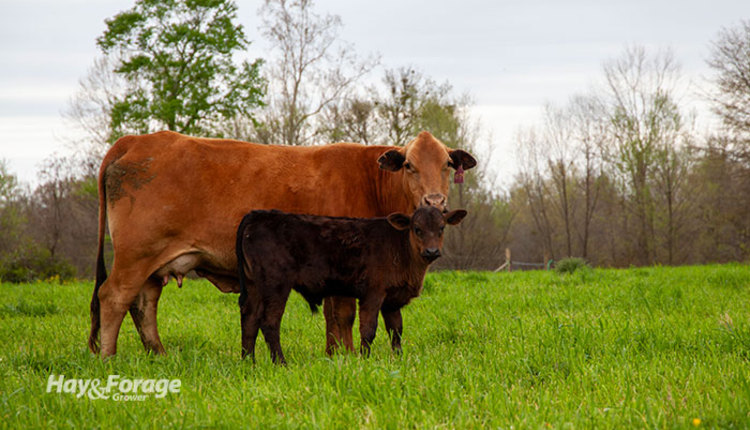
Graziers from across the country recently gathered in Hershey, Pa., for the Grassfed Exchange. From grass-fed beef and organic dairy to pasture-raised poultry, sheep, and goats, the types of farms represented at the conference ran the gamut of grazing systems.
Rotational grazing, holistic grazing, and management-intensive grazing were popular topics of conversation at the event. Sarah Flack, a grazing consultant from Vermont, has studied each of these management styles, but instead of specializing in one approach, she focuses on the underlying principles of each practice that can be applied on any operation.
During Flack’s presentation, titled “Next Level Grazing,” she discussed what she calls the grazier’s toolbox or the aspects of grazing management that producers can implement or adjust to improve their pastures. These tools include occupation and rest periods, stocking rate and density, grazing patterns, trampling, and fallowing.
Flack explained how each tool in the grazier’s toolbox can boost pasture productivity, change forage composition, benefit soil health, and enhance livestock production. For example, shortening occupation periods and giving forage more time to rest can encourage better stand persistence. Moreover, changing the direction in which paddocks are rotationally grazed year to year can boost overall plant growth.
Not all tools are applicable to everyone, though, and not all practices are feasible on every farm. Flack said producers must observe and monitor their livestock and forage when they tweak their grazing plans to ensure the change has positive effects rather than negative ones.
“The first thing you should do when making your grazing plan is assume it is wrong,” Flack said, sharing advice that she received in the past. “That will force you to observe and monitor your system. Find the warning signs that you need to be looking for. Catch them early and correct your actions.”
Monitoring livestock
First, Flack told listeners to look at their livestock before looking at their forage. Animals’ body condition and grazing behavior can reveal important information about forage quantity and quality. For cattle, examine rumen fill on the left side of an animal’s body between its last rib and hook bone. Adequate rumen fill suggests cows are consuming enough forage of sufficient quality.
“We are trying to figure out how to feed animals forage and maximize their intake so they can quickly and efficiently fill their rumens with something that is digestible and has a good passage rate,” Flack said. “We don’t want to be filling their rumens up with overmature forage that is slow to digest and will affect their ability to eat enough.”
In addition to rumen fill, Flack said rate of gain and reproductive data from the herd can point out areas of improvement of a grazing system. Slow rates of gain and/or breeding rates that are lower than normal should signal producers to open their grazier’s toolbox and make changes to their grazing plan.
The consistency of cow manure can also reveal information about forage quality, and milk urea nitrogen (MUN) content can help producers estimate the balance between energy and protein in forage consumed by dairy cattle. Moreover, minimizing heat stress in all species of livestock is key to a sound grazing system.
Monitoring forage
After assessing the herd, turn your focus to the forage. Flack said monitoring pastures allows producers to understand and manage dry matter intake. She explained dry matter intake can be determined by multiplying time spent grazing by bite rate and intake per bite. While bite rate varies among animal species, intake per bite varies with pasture composition and forage density.
“If you have cows, bite rate is going to be in the ballpark of 25,000 bites per day. If you have sheep, it is going to be more like 50,000 bites per day,” Flack stated. “One of the best ways to increase intake per bite is to have more grass tillers per square foot. The more tillers there are, the more productive that pasture will be, and the more forage livestock can eat.”
Flack told attendees to go into their fields and inspect forage density and pasture composition from the ground level. She noted that plant height and canopy density don’t always tell the whole story, especially in her region of the northeastern U.S., which has experienced excessive rainfall this growing season. In such situations, lush vegetation from large amounts of precipitation can cover up how few tillers per square foot a stand really has.
“Get down on your hands and knees and really look at plant density,” Flack said. “Really look at how much space there is between plants and where there is bare soil. Also look for diversity. Make sure you have grasses, legumes, and forbs, and that you are pushing toward more perennials.”
Flack recommended taking soil samples and assessing soil fertility. In addition to nutrient levels, organic matter is a good measure of pasture condition. Other biological markers like insects and earthworms are signs of plant health above and below the soil surface.
Overall, Flack encouraged the audience to constantly observe and monitor livestock and forage in their pastures. Understanding the tools in the grazier’s toolbox can help advance grazing systems to the next level, but producers must be able to identify the changes in livestock and forage production that those tools create.

